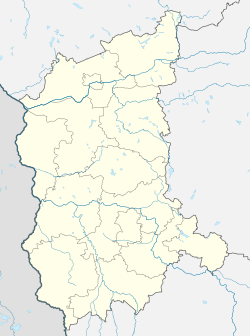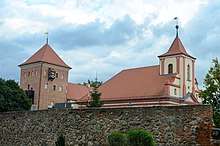Sulechów
Sulechów (pronounced Sue-leh-hoof [suˈlɛxuf], German: Züllichau) is a town located within the Zielona Góra County, in Lubusz Voivodeship, western Poland. It is the administrative seat of the Gmina Sulechów. Established in the Middle Ages, the town features many historical monuments significant to the Polish Lubusz Voivodeship (since the Local Government Reorganization Act of 1998). From 1975–1998 Sulechów was part of Zielona Góra Voivodeship. The town limits cover 6.88 square kilometres (2.66 sq mi). Olga Tokarczuk, the Nobel Prize in Literature winner for 2018 was born in 1962 in Sulechów.
Sulechów | |
|---|---|
Town hall | |
 Flag  Coat of arms | |
 Sulechów  Sulechów | |
| Coordinates: 52°5′N 15°37′E | |
| Country | |
| Voivodeship | |
| County | Zielona Góra |
| Gmina | Sulechów |
| Government | |
| • Mayor | Wojciech Sołtys (2018–2023) |
| Area | |
| • Total | 6.88 km2 (2.66 sq mi) |
| Population (2019-06-30[1]) | |
| • Total | 16,831 |
| • Density | 2,400/km2 (6,300/sq mi) |
| Time zone | UTC+1 (CET) |
| • Summer (DST) | UTC+2 (CEST) |
| Postal code | 66–100 |
| Area code(s) | +48 68 |
| Car plates | FZI |
| Climate | Cfb |
| Website | sulechow.pl |
Geography
Sulechów is situated in the historic Lower Silesia region, north of the Oder river. The town centre is located about 22 km (14 mi) northeast of the regional capital Zielona Góra, where the national road 32 to Poznań crosses the expressway S3 to Gorzów Wielkopolski. The regional Zielona Góra Airport is about 14 km (8.7 mi) away.
History
The settlement of the region on the Middle Oder dates back to the 4th century AD.
Medieval Poland
By conquest at the end of the 10th century the area became part of the Polish realm of the Piast dynasty. It became part of the Duchy of Silesia, a province of fragmented Poland, in 1138, and, later belonged to the Silesian Duchy of Głogów,[2] established in 1249-51 under the rule of Duke Konrad I.

The settlement itself was first mentioned in a 1319 deed, at the time when the warlike Ascanian margrave Waldemar of Brandenburg campaigned the area, occupying Sulechów and neighbouring Świebodzin. Margrave Waldemar, however, died in the same year, and the localities fell back to the Piast dukes of Głogów.[2]
When the last Piast duke Henry XI of Głogów died without issue in 1476, inheritance claims were raised by his widow Barbara of Brandenburg and her father, the Hohenzollern elector Albrecht Achilles. The Brandenburg influence met with fierce opposition by Henry's Piast cousin, Duke Jan II the Mad of Żagań, who nevertheless after several years of fighting had to sign an agreement, whereby the Silesian towns of Crossen (Krosno) and the town passed to the Margraviate of Brandenburg as a fief of the Bohemian (Czech) Kingdom.[3]
Modern era
Along with Crossen, Sulechów, under its German name Züllichau,[3] was incorporated into the Brandenburg Neumark district by 1535, ruled by Margrave John of Brandenburg-Küstrin who implemented the Protestant Reformation. Two years later, the Piast duke Joachim of Münsterberg-Oels and his younger brothers officially waived any rights to the Crossen and Züllichau territories. Part of Brandenburg-Prussia from 1618, the town was devastated during the Thirty Years' War but again flourished under the rule of the "Great Elector" Frederick William. From the 17th century, clothmaking developed.[3]
Züllichau was part of the newly established Kingdom of Prussia since 1701. It became a garrison town of the Prussian Army. The Polish minority resisted Germanisation attempts, carried out by the Prussian authorities.[3] From 1815 it belonged to the Province of Brandenburg and became the administrative seat of the Züllichau-Schwiebus rural district within the Frankfurt Region. In 1828, 18-year-old Frédéric Chopin visited the town and gave an improvised concert.[4] Between 1871 and 1945 Züllichau was part of the German Reich.
During World War II the Germans established two forced labour camps in the town, mainly for the Soviets.[3] The territory was conquered by Red Army forces during the Vistula-Oder Offensive in the final stage of World War II. In accordance with the Potsdam Agreement, the town was incorporated into the Republic of Poland by the implementation of the Oder–Neisse line in 1945, while the remaining German population was expelled. The historic Polish name Sulechów was restored.
.jpg)
Notable people
- Johann Gottfried Rösner (1658–1724), mayor of Thorn (Toruń) as a consequence of the Tumult of Thorn
- Caspar Neumann (1683–1737), first pharmaceutical professor at the Berlin Collegium Medico-Chirurgicum
- Johann Gottfried Ebel (1764–1830), author
- Carl Friedrich Ernst Frommann (1765–1837), bookseller and publisher
- Minna Herzlieb (1789–1865), role model for "Ottilie" in Goethes "Die Wahlverwandtschaften"
- Hermann Marggraff (1809–1864), author
- Theodor Kullak (1818–1882) pianist, composer was educated in the town.
- Rüdiger Graf von der Goltz (1865–1946), a German Major-General during World War I and Estonian War of Independence
- Gerhard Benack (1915–1994), German officer
- Nicholas Forell (1923–1998), engineer
- Peter Robert Keil (born 1942), German painter and sculptor
- Klaus-Dieter Ludwig (1943–2016), German rower
- Olga Tokarczuk (born 1962), writer, winner of the Man Booker International Prize as well as the Nobel Prize in Literature
- Łukasz Żygadło (born 1979), volleyball player
- Mela Koteluk (born 1985), singer
Twin towns – sister cities
See twin towns of Gmina Sulechów.
References
- "Population. Size and structure and vital statistics in Poland by territorial divison in 2019. As of 30th June". stat.gov.pl. Statistics Poland. 2019-10-15. Retrieved 2020-04-11.
- Sulechów - Internetowy Serwis Miejski Archived 2011-12-29 at the Wayback Machine
- "Sulechów". Encyklopedia PWN (in Polish). Retrieved 5 February 2020.
- Sulechów - Internetowy Serwis Miejski - Fryderyk Chopin w Sulechowie Archived October 27, 2011, at the Wayback Machine
External links
| Wikimedia Commons has media related to Sulechów. |
- Official website
- Jewish Community in Sulechów on Virtual Shtetl